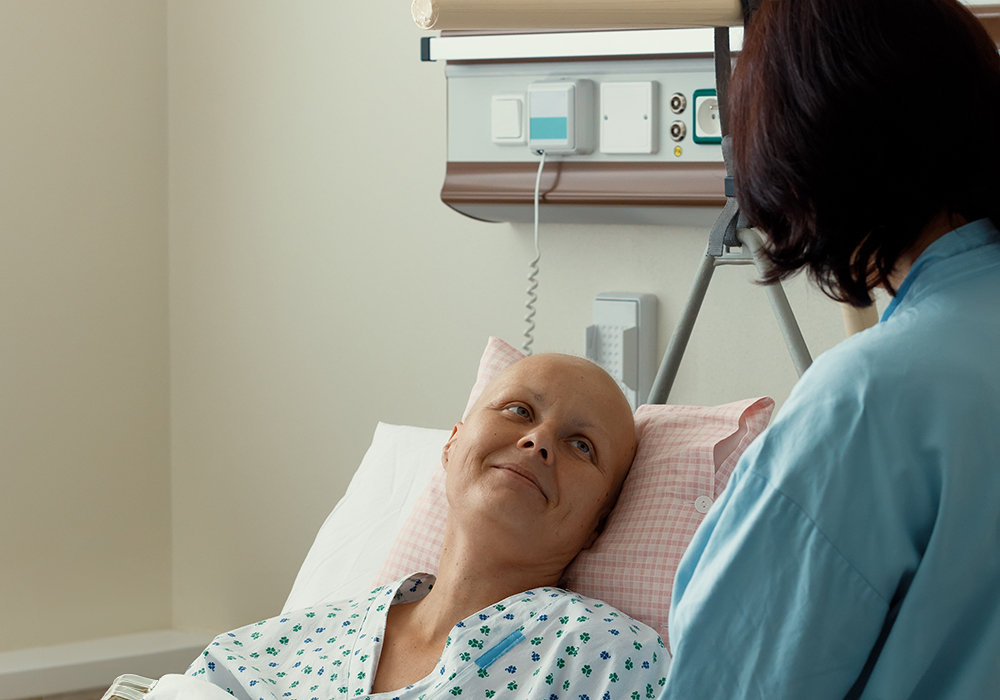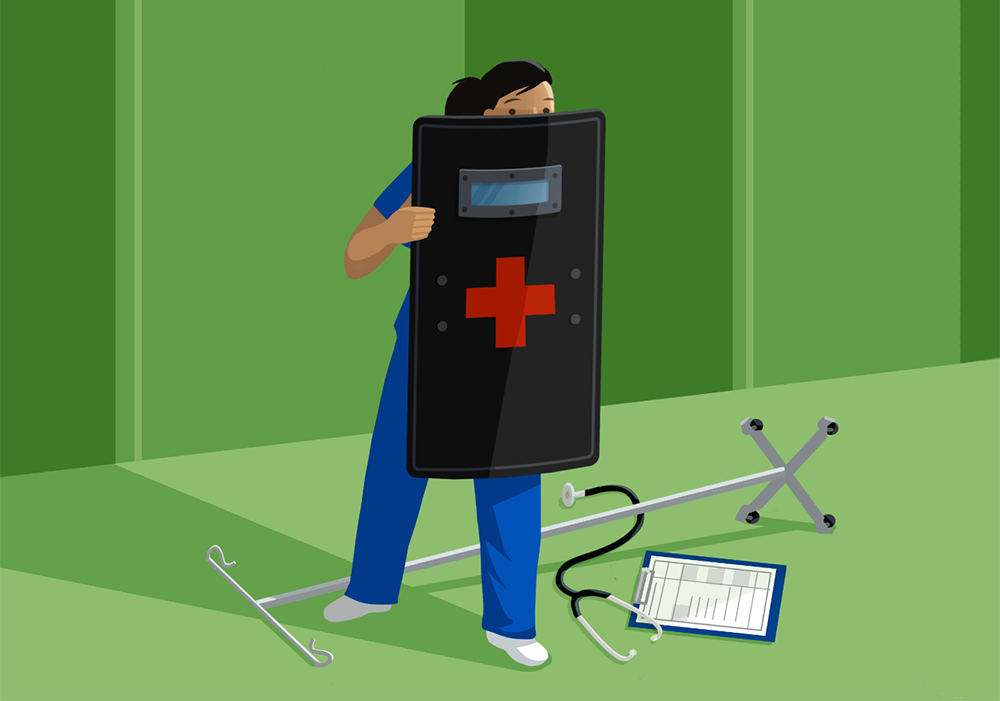Across all nursing specialties and settings, 60% of nurses reported experiencing an incident of workplace bullying and incivility and 29% confronted at least one incident of violence in 2022, according to the American Nurses Foundation 2022 Workplace Survey report. And it’s escalating—violence against hospital employees and healthcare professionals has increased since the onset of the COVID-19 pandemic in early 2020, with 44% of nurses reporting having experienced physical violence and 67% verbal abuse between February and June 2020 alone.
Nurses reported incivility or bullying from patients (55%), patients’ families (49%), staff nurses (42%), managers or supervisors (36%), and other groups; and violence from patients (90%), patients’ families (38%), the public (10%), staff nurses (6%), and other groups. And the numbers were even greater for nurses working in acute care settings, with 65% and 40% reporting incivility and violence, respectively.

“When I think of workplace violence, I think beyond the physical abuse or attacks that may occur directly to a nurse,” ONS member Penne McPherson, EdD, RN-NPC, OCN®, faculty member at the Denver College of Nursing in Colorado and member of the Metro Denver ONS Chapter, said. “My research for my doctorate program was focused on incivility, also known by other names such as lateral violence, bullying, and workplace incivility. I believe a person’s spirit can be destroyed as easily, if not more so, as a broken bone from a physical attack.”
The Occupational Safety and Health Administration (OSHA) defines workplace violence as “any act or threat of physical violence, harassment, intimidation, or other threatening disruptive behavior that occurs at the worksite,” which can include any types of threats from verbal abuse to physical assaults. The National Institute for Occupational Safety and Health classifies workplace violence into four basic types, with types II and III occurring most commonly in health care:
- Type II involves a customer, client, or patient who has a relationship with the business and becomes violent while receiving services.
- Type III involves a worker-on-worker relationship and includes employees who attack or threaten other employees.
“I think most nurses and other healthcare professionals can recall moments where they felt very uncomfortable or unsafe, and yet they did not recognize that what they were experiencing was likely workplace violence,” ONS member Suzanne Carroll, RN, MS, AOCN®, oncology clinical nurse specialist who works as a freelance oncology nurse consultant in Buffalo, NY, said. “It is also important to recognize that violence and harassment can occur both in person and electronically. Acknowledging the electronic component is vital because personal attacks can ensue on social media.”
Acts of workplace violence take a heavy physical and emotional toll on nurses and other healthcare professionals, presenting in a spectrum of burnout symptoms ranging from low productivity and job satisfaction to sleep disorders and exhaustion. It can even have implications for patient safety.
“Workplace violence and incivility create an environment where it is difficult to have a collaborative team effort in patient care,” McPherson said. “It destroys self-confidence and thus self-competence. Patient care is adversely affected. Nursing loyalty, engagement, and satisfaction diminish. And increased turnover and sick calls become more frequent.”

Violence From Patients and Caregivers
“I think we experienced workplace violence in the form of verbal abuse over the past two years with the pandemic, particularly over visitor restrictions,” Carroll said. “Families were very angry at visiting restrictions, and nurses, healthcare aides, and clerical staff received the brunt of their verbal tirades. Looking back at this now, I think the anger that was expressed stemmed from fear. Who wouldn’t be scared and angry if they were not allowed to accompany their loved one during their cancer treatment or hospitalization?”
Institutions must create formal strategies for violence from patients, families, and caregivers, and oncology nurses must be trained to de-escalate those situations and keep themselves and their colleagues safe from harm, Carroll said. The best approach is to assess each incident individually, just as you would patient care. The factors behind the behavior are multifaceted, and de-escalation may not be as effective in patient violence from drivers like disease stage or medications.
“De-escalation is a first-line response to potential violence and aggression in healthcare settings,” Carroll said. “When I worked in a large academic setting that had psychiatric and emergency patients, we had a team in place to deal with violent situations from patients, families, and caregivers that we summoned by calling a ‘Dr. Armstrong’ page to the area.”
Carroll added that most organizations have policies that address workplace violence, but they don’t replace a formal de-escalation plan or team to respond to the situations in real time.
“Techniques to de-escalate violence are also referred to as talk-down, conflict management, and defusing,” Carroll said. “In de-escalation situations, remain calm and use clear, nonconfrontational communication (i.e., don’t raise your voice). Most aggressive behaviors come from a place of fear and uncertainty. Respond with respect and be authentically supportive of the issues and problems that aggressors are communicating.”
Carroll also encouraged nurses to plan for a backup if they think they might enter a potentially volatile situation, such as telling another staff member of their location or asking a staff member to accompany them or be very close by.
Overall, 25% of nurses are victims of sexual harassment from patients and caregivers.
Violence takes many forms, including sexual harassment. Carroll said that overall, 25% of nurses are victims of sexual harassment from patients and caregivers.
“I can recall many instances where I personally experienced sexual harassment from patients, caregivers, and visitors,” Carroll said. She added that there was little to no reporting of the incident completed afterward. “It was a sidebar discussion with fellow nurses to ‘warn them of the harassment,’ and it was certainly never reported.”
In response to the October 2017 #MeToo movement, Carroll said that her institution conducted a small survey of 55 respondents to research the prevalence of sexual harassment in nursing from patients, caregivers, and visitors. Of those 55 individuals, Carroll reported that 37 experienced unwanted sex-related attention, including sex- or gender-related talk or unwanted or uninvited behavior such as sexual or offensive stories or jokes, whistles or hooting, unwelcome attempts to be drawn into a discussion about sexual matters, and unwanted attempts to stroke, fondle, or kiss. Of those 37 individuals, only 2 filed a formal complaint after the incident occurred. Carroll tagged the experiences as #NursesToo, and although the pandemic prevented her from expanding on the findings, she said she’s interested in collaborating with other nurses on the next steps for formal strategies for change.
Sexual harassment can happen to nurses of any gender or sexual orientation, Carroll added. “It is essential that we recognize the existence of all harassment, including to men and the LGBTQIA+ population, who have been marginalized for years,” she said.
In a previous position as an oncology educator for 17 hospitals and 4 clinics across Colorado and Kansas, McPherson taught a class on managing conflict and responding professionally to bullying and workplace incivility using emotional intelligence. She explained that many times, a violent situation can be avoided if some of the techniques taught in class are used. The class participated in role playing to practice identifying conflict and setting boundaries.
“I use the example of an angry husband literally yelling and being physically expressive at the nurses’ station over the care his wife is not receiving,” McPherson explained. “I role-play showing him doing this while loudly expressing, ‘What kind of place is this? My wife hasn’t had a bath in a week. Are you really nurses?’ and other demeaning language and actions.”
McPherson explains that the husband’s actions may be the result of loss of control over his wife dying, rather than anything the nurses did or did not do. “Then I describe two choices the nurses have,” McPherson said. “They can respond in an aggressive, abrupt way and let him know they are calling security, or I role-model a softer approach,” which includes a conversation that allows the husband to regain control of his emotions and addresses any concerns that need to be supported. During the scenario, McPherson shows how nurses can remain visible to other staff and have an easy escape route should the husband get violent.
“Violence prevention must be incorporated in oncology workplace settings to reduce or eliminate the risk of workplace violence,” Carroll said. She cited OSHA's five essential building blocks for an effective workplace violence prevention program:
- Management commitment and employee participation
- Worksite analysis
- Hazard prevention and control
- Safety and health training
- Recordkeeping and program evaluation
“All oncology settings should have de-escalation plans and in some circumstances, a formal team,” Carroll said. The plans should incorporate a formal reporting mechanism and debriefing about factors that contributed to the violence and what could have been done differently—and involve patients, family, and staff in the debriefings when possible.
From there, staff training on de-escalation techniques is essential, according to Carroll. “This is best accomplished using practice techniques in an education setting where participants can actively engage, ask questions, and share experiences.”
The solutions are simple: Recognize incivility and that any act is intolerable, create a speak-up culture, and advocate for anyone who’s a victim.
Violence and Incivility From the Interprofessional Team
McPherson said that nurses commonly experience workplace violence, bullying, or incivility from a colleague or another member of the interprofessional team. According to the Joint Commission, 44% of nursing staff have been bullied, and nurses “tend to accept nurse-on-nurse bullying as part of the job.” And the effects accumulate, McPherson said. “Workplace violence, bullying, and incivility can happen to one nurse several times a day from different people: an angry provider, a confrontational coworker, the dietary staff, and on and on.”
To understand the personal and professional implications of workplace incivility and identify interventions to counter it, McPherson conducted a study that captured the perceptions of several RNs who had experienced it. The RNs reported acts of workplace gossip, sabotage, physical violence, and even incivility after accepting a new position, yet they said that the solutions are simple: Recognize incivility and that any act is intolerable, create a speak-up culture, and advocate for anyone who’s a victim.
Those solutions apply to leaders, too, but McPherson said that sometimes leaders perpetuate the behavior. In those situations, McPherson said that she works with staff to schedule appointments with the highest level of safe leadership and has also consulted with the institution’s chaplain as a resource.
“I found a saying, ‘What you permit, you promote,’” McPherson said. “I use it in my classes and with counseling staff who come to me for advice. We work on real-life scenarios and how to best handle a particular situation.”
Use Your Voice to Protect Yourself, Your Colleagues, and Your Patients
Thanks to nursing advocacy, policymakers are also recognizing the prevalence of violence in the workforce and pushing for change. National legislation introduced in 2021 and 2022 during the 117th Congress included:
- The Workplace Violence Prevention for Health Care and Social Service Workers Act requires covered employers in the healthcare and social service industries to develop and implement a comprehensive workplace violence prevention plan.
- The Safety From Violence for Healthcare Employers Act would give healthcare workers the same legal protections against assault and intimidation that flight crews and airport workers have.
Both acts must be reintroduced in 2023 to gain forward momentum, so contact your members of Congress to show your support for the bills.
Several states also have legislation to protect nurses and other healthcare professionals, such as Maryland’s Peace Order Bill and Tennessee’s decision to add nurses to a statute on assault against a first responder.
By raising awareness and advocating for legislation that protects you and your colleagues from workplace violence, you are creating a safer environment for all. If you’d like to lend your voice to make real change, Carroll suggests working with your professional nursing organizations to create position statements that address workplace violence in the nursing profession, like the American Nurses Association’s position on incivility, bullying, and workplace violence.
Recognizing violent behavior, whether from colleagues or patients; maneuvering those situations in a professional manner; working with trusted team member; and advocating at the local, state, and national levels for legislation that protects nurses in all specialties have a lasting impact on the profession and your own well-being.
“Oncology nurses care for patients when they are the most raw,” McPherson said. “Just as a soldier in battle may come home with post-traumatic stress, oncology nurses can also experience much of the same.” She added that nurses must recognize themselves as victims of workplace violence and have workplace support so they can continue to give great patient care.
“I think the most important thing is to listen to and trust your own feelings if you are the victim of workplace violence, and perhaps even more importantly, listen to your coworkers if they share concerns about workplace violence from patients, families, or visitors. Once workplace violence is legitimized, we can implement actions to address it,” Carroll said.






